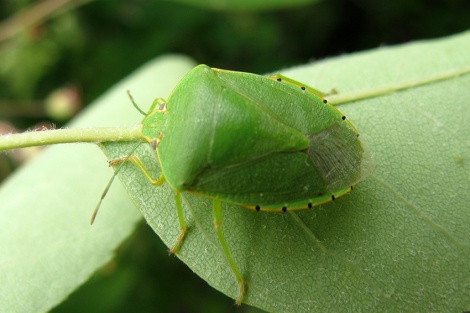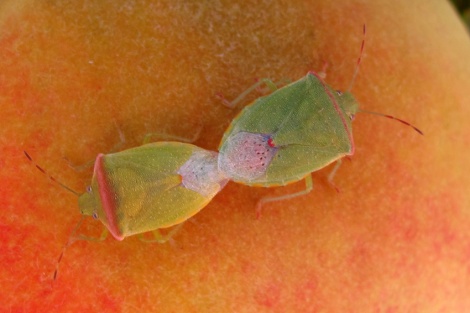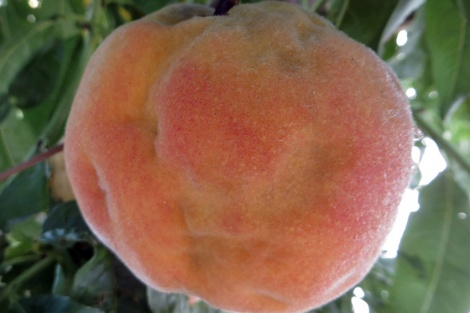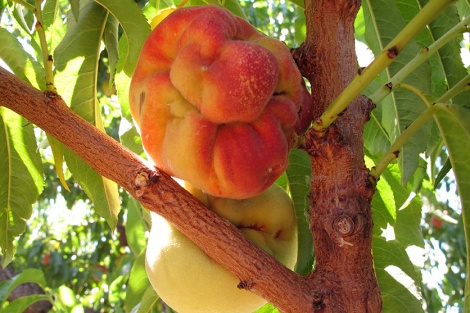In this Issue
- Apple, Pear: codling moth updated dates, bitter pit
- Peach, Apricot, Plum, Cherry: stink bugs, peach twig borer updated dates, greater peachtree borer, cherry post-harvest treatment
- Berries: raspberry crown borer
- Other Information: update on invasive species monitoring
APPLE, PEAR
Codling Moth
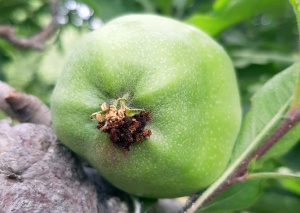
View a pdf of the spray timing table. Be sure to read the instructions at the top of the page, for how to read the table.
Egg hatch of the second generation is nearing the end of the period of rapid egg hatch in north-central Utah. Make sure the fruit is well-protected so you can have a good crop.
The second generation of egg hatch will end toward late August. In the warmer areas of northern Utah, a third generation will “blend” into the end of the second, with egg hatch beginning again just a few days later.
Keep in mind that you do not need to worry about keeping fruit protected from codling moth after September 15. The changing day-length “signals” the larvae to enter a resting stage (diapause) for the winter.
See this earlier post (and scroll down to Codling Moth) for treatment options.
Bitter Pit
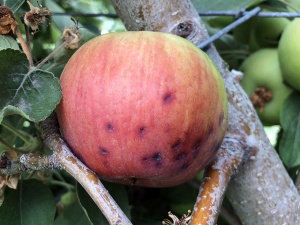
Bitter pit may occur when not enough calcium reaches apple fruits, causing sunken, brown lesions on the skin and flesh. The lesions are located mainly on the bottom (calyx) end of the fruit and are circular in shape. Sometimes, lesions do not show up until a month or more in storage.
Conditions that may lead to bitter pit include:
- hot, dry weather in July or August
- heavy dormant-season pruning
- low fruit set caused by overthinning, poor pollination, or alternate bearing
- excessive nitrogen fertilizer leading to vigorous shoot growth
- irregular soil moisture (preventing the constant flow of calcium)
- injury to trunks, such as winter freezes, interferes with calcium movement
- Susceptible varieties: Honeycrisp, Baldwin, Northern Spy, Granny Smith (moderately susceptible), Mutsu, Gravenstein, Grimes Golden, Yellow Newtown, and Jonathan
Treatment
On some varieties (Honeycrisp), calcium sprays are required every year, applied once per month starting about 2 weeks after bloom. If you have not done this and your fruits have had bitter pit in the past, consider 1 to 2 calcium sprays (applied several weeks apart) on expanding fruit before harvest. Calcium chloride or calcium nitrate at not more than 5 lb/100 gal are options. Some studies have found that calcium nitrate works better later in the season, but it may interfere with color formation. Do not spray at temps above 80-85F, and add a surfactant to all sprays to reduce the possibility of burning.
Avoid spraying Crispin and Golden Delicious with calcium nitrate, since fruit damage may result.
After harvest, a 4% calcium chloride dip is also effective. Store fruit immediately and wash before eating. (Note that calcium chloride is corrosive to metal.)
For preventing bitter pit, an integrated approach of the following cultural practices is important:
- avoid wide fluctuations in soil moisture
- do not over-fertilize to avoid vigorous growth and over-sized fruit
- do not over-prune in winter
- try to prevent biennial bearing through proper thinning and pollination practices
- harvest at optimal timing because late-harvested fruit is prone to bitter bit
PEACH, NECTARINE, APRICOT, PLUM, CHERRY
Green Stink Bugs and Cat-Facing Injury
You’ve most likely heard the news or seen the videos of stink bug and other insect “invasions” occurring in southern Utah and Nevada. And they are also occurring in northern Utah. USU Extension has had multiple inquiries and reports of green-colored stink bugs in a variety of crops along the Wasatch Front. There are several species of stink bugs that are green in color, including the appropriately-named green stink bug (Chinavia hilaris), and entomologists at USU have also identified Say’s stink bug (Chlorochroa sayi), red-shouldered stink bug (Thyanta custato), and a small stink bug, possibly in the genus, Tepa.
The reason for the population explosion of these and other pests (false chinch bug, grasshoppers, Mormon crickets) is due to the mild, wet winter followed by the cool, wet spring and cooler-than-average evening temperatures. Stink bugs overwinter as adults and a large population that survived the winter most likely emerged later in the season than normal, and simultaneously in mass numbers.
The risk for fruit growers is that stink bugs will move to ripening fruit. There have already been reports of damage to tart cherries. The bugs may move to apricots, followed by peaches/nectarines, and finally apples. By late-August, stink bugs move on to search for overwintering sites.
Stink bugs feed with a straw-like mouthpart, excreting a salivary enzyme that breaks down the cells, and then sucking up the dissolved food juices. Early-season feeding results in “cat-facing”, where the fruit does not develop fully because of the feeding damage. Later-season feeding causes the fruit to be unmarketable, where feeding sites on the fruit turn brown and corky, and fungi or bacteria may be introduced. Sometimes, injury does not show up until fruit is brought out of storage.
It will be important to monitor your own trees and orchards for stink bug activity. Areas that border natural lands, weedy areas, or fields, will be most at risk. The best way to check trees for stink bugs is to lay a white sheet or cloth on the ground and shake branches over the sheet to see what insects fall. There is no threshold established, so if stink bugs are found on the cloth, take time to inspect the fruit for damage before making a decision on applying a pesticide.
The most effective products on adult true bugs are the broad-spectrum insecticides (carbaryl and pyrethroids, including the organic pyrethrin). Only consider a treatment if it is worth the cost of killing beneficial insects that may be feeding on other pests.
Greater Peachtree Borer
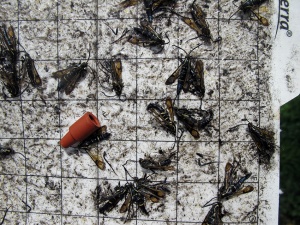
We are catching high numbers of peachtree borer in many areas of northern Utah. Continue to maintain protection of the lower trunk of peach/nectarine and apricot (where necessary), with your last treatment early to mid-September. When you spray, be sure to move mulch or weeds away from the trunk (or even excess soil) because sometimes eggs are laid below-grade.
This fall or next spring, inspect a random selection of trees. Remove dirt from around the base of the tree down to about 4 inches. Look for oozing gum mixed with frass. If you find any symptoms, you will know that you need to improve your control program for next year.
Note that there’s not much you can do about successful entries that you find, unless you want to carefully search for the larva under the bark. Cut a small amount of bark away (vertically) to find the larva, or insert a strong but thin wire into the borer hole. Take care in using these methods so that you do not damage the tree more than a single borer would.
Peach Twig Borer
View a pdf of the spray timing table. Be sure to read the instructions at the top of the page, for how to read the table. (Note: some dates are in italics because they are past dates.)
For many northern Utah locations, egg hatch for the second generation has started or will start soon. For the second generation (third generation in southern Utah), your treatment plan will depend on last year’s damage. With low damage, you can apply one spray (or none if early season treatment was applied). But keep in mind that the warmer temperatures we have been experiencing will speed up egg hatch and larval development, and if you are harvesting peaches late into August and/or early September, you may need to apply a second application to protect the ripening fruit.
Cherry Trees, Post-Harvest

To reduce powdery mildew, apply a spray of 1 to 1.5% oil (200 gal/acre) in mid- to late August to reduce the formation of overwintering spores that occur on leaves and bark. The oil will also reduce spider mite populations.
To reduce cherry fruit fly, apply a “clean-up” insecticide about 7 days after harvest is complete. The peak flight period of this insect actually occurs later in the season, after harvest. So any fruit that remains on trees after cherry harvest represents a source for infestation of cherry fruit fly the following season.
Commercial producers can use imidacloprid (Admire Pro, or generics) or dimethoate plus 1% oil.
Backyard growers should remove and destroy all fallen fruit, and if possible, pick your cherry trees clean to remove egg-laying sites for late-emerging fruit flies. If this is not possible, spray once with Spectracide Triazicide, GardenTech Sevin, or for organic production, a product containing pyrethrin. Please keep your trees clean of this pest because it can devastate a commercial producer’s crop.
SMALL FRUITS
Raspberry Crown Borer
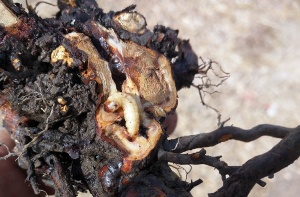
If you are noticing entire canes or plants wilting in your raspberry field, it is possibly damage from the raspberry crown borer. Currently, the larvae of this pest are actively feeding and tunneling in the roots and crowns, which cuts off the flow of water and nutrients.
To determine crown borer, yank on the symptomatic cane. If you can easily pull it out of the ground, it could be crown borer. Look at the broken end, and you may see some tunneling damage in the lower part of the cane.
The raspberry crown borer is called a clearwing moth. The larvae live and bore into the crown and roots of blackberries, raspberries, loganberries, and wild brambles for two years. Young larvae feed on the smaller roots, and as they get larger, they move to the crown. Damage is most evident during the second year of larval activity. Mature larvae pupate to a moth in mid to late August.
The problem with this pest is that low levels of infestation can suddenly develop into a severe problem, so it is important to keep an eye on the health of your plants during the entire season.
Early fall is the best time for treatment because at that time, larvae exit the upper crown of the plant and travel down in the soil to the roots for the winter. In infested sites, at least two years of diligent treatment is necessary.
Treatment
- drench roots with bifenthrin in early fall
OTHER INFORMATION
Update on Invasive Fruit Pests – Brown Marmorated Stink Bug (and its enemy, Samurai Wasp) and Spotted Wing Drosophila
Dr. Lori Spears, Invasive Species Specialist, runs a trapping program in Utah for a number of invasive pests, including two pests of concern in fruits, brown marmorated stink bug (BMSB) and spotted wing drosophila (SWD).
Brown Marmorated Stink Bug
Spears and her team maintain and monitor more than 70 traps in more than 35 sites across northern Utah. To date, BMSB has been found on traps in the following counties. The greatest amounts continue to occur in the Salt Lake City area, but so far this season, no crop damage (due to BMSB) has been reported.
- Cache County – 3 total specimens
- Box Elder County – 4
- Weber County – 64
- Davis County – 19
- Salt Lake County – 104
- Utah County – 11
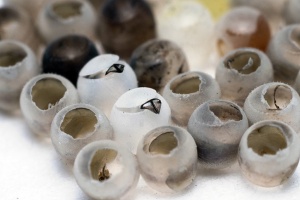
The big news is that the Samurai wasp (Trissolcus japonicus) was detected in Utah. This wasp, native to the same Asian countries as BMSB, is a highly effective natural enemy of the stink bug. Female wasps kill the stink bugs by parasitizing their eggs. She lays a single egg inside each stink bug egg, and the developing wasp larva uses the stink bug egg contents as food and shelter. Scientists have found that where this wasp occurs, as many as 80% of stink bug eggs can be parasitized.
USU Biology graduate students, Zach Schumm and Cody Holthouse have been searching for the Samurai wasp by clipping cards containing BMSB egg masses (laid in a rearing chamber) to leaves in various locations in northern Utah, and then monitoring these eggs for parasitism. On June 17, 2019, two egg masses on northern catalpa leaves in Salt Lake City were collected and a total of 49 Samurai wasps emerged from the parasitized eggs.
The wasps were kept alive and will help to initiate a larger colony of Samurai wasps that can be released into the wild as biocontrol agents. To date, Samurai wasp has been detected in more than 11 U.S. states, and is being released in several of them.
For more information, see the following:
- USU Extension Guide: Invasive Fruit Pest Guide for Utah
- Utah Pests Fact Sheet: BMSB
- Utah Pests Fact Sheet: Parasitoid Wasps of the Invasive BMSB in Utah
- www.stopbmsb.org
- Traps are lures are available from Trece.
Spotted Wing Drosophila
Spears has 54 traps in 27 northern Utah locations. To date, no flies have been captured. In past years, her traps have started to catch flies anywhere from late July to September.
For more information, see the following:
- USU Extension Guide: Invasive Fruit Pest Guide for Utah
- Utah Pests Factsheet – General Information on SWD
- Utah Pests Factsheet – Monitoring SWD
- Utah Pests Video – Trapping and Identifying SWD
- Washington State University’s SWD website
- Oregon State University’s SWD website
- Pheromone lures are available from Trece and Scentry.

